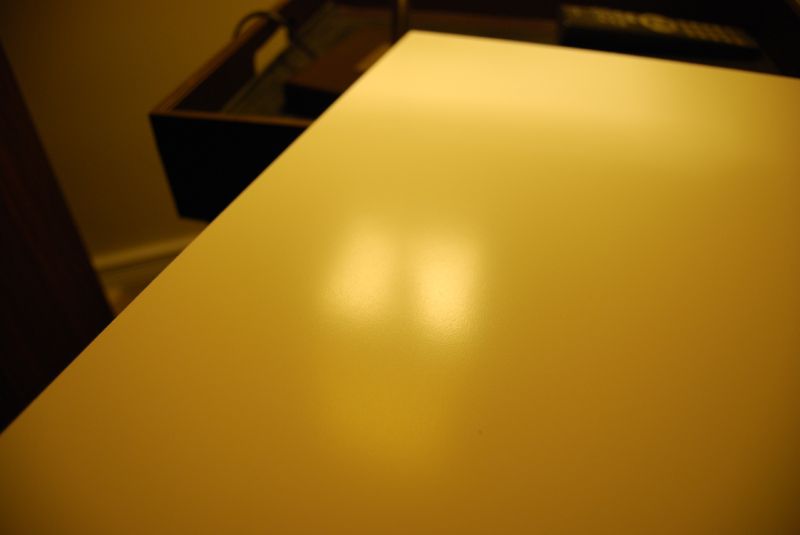Troubleshooting Orange Peel with Waterborne Lacquers
Formula thinning and spraygun adjustments solve an orange peel problem for a finisher. April 29, 2011
Question
Has anyone had issues with waterborne lacquers developing orange peel once they start drying? I have a nearly perfect primed and sanded surface before I shoot the topcoat. Once the topcoat is down, it looks like wavy glass, but as it cures it develops fine orange peel.
Forum Responses
(Finishing Forum)
From contributor J:
Is this happening with clears and pigmented finishes or just the pigmented ones? Are you thinning it in any way at all, and what type of equipment are you spraying it with and at what temperature?
My first step would be to try thinning it 5% and see what happens. If it gets better but not perfect, then try another 5%. If the temp of the room is under 68 degrees, I would try to bump it to 70 and see if that helps. There are also flow additives that most companies offer to help with this sort of thing and you might find that something like that is the perfect product to thin it with. Also, try thinner coats.
From the original questioner:
I've only been using pigmented lacquer (Becker) and I haven't been thinning it. I'm using a Kremlin 10-14 (15-20 psi air, 35-45 psi material). I'll try increasing the shop temperature and thinning it like you say. I just thought it was strange that it looks so smooth wet, yet dries to an orange peel texture. One more thing - I'm using a 50 sheen. I got it by mistake. I'd like to use something much more flat. Would a lower sheen flow better or would you just not notice it as much?
From contributor J:
Becker makes top notch products. I would try what I recommended and you might see a better result.
I haven't sprayed solvent based pigmented products for a few years since going WB, but you might also want to look at the tip size you are using. I know that my WB manufacturer just improved their pigmented finish and I was not getting the finish I used to, but going to a different size tip cured the problem and now things are better than ever.
You might also get better results by experimenting with different air and fluid settings. Maybe try to reduce the fluid pressure and increase the air pressure a bit at a time and see if things get better.
From contributor J:
Sorry about the post above. I misread it and thought you were using the SB stuff. At any rate, I would still answer the question the same way, so just disregard the SB stuff I threw in there.
From contributor S:
Sounds to me like you are heavy on the trigger and overdoing it. Light sand, clean, and thin the final coat. Sometimes my sanding is so fine, even flat look satin.
From contributor B:
I had the same issue once using Sealcoat as a sealer. It seems Sealcoat is formulated to be able to be cleaned up with ammonia. Ammonia is also a product in many waterborne lacquers. The topcoat softened the sealer, then hardened on top of it.
From the original questioner:
I'm using Becker waterbased primer, so I don't think there should be an issue. I will have to play around with the viscosity, air settings and amount I'm putting on.
From contributor M:
I spray Becker pigmented water base a lot. It is pretty thick and needs to be thinned for my 10-14 with an 09 tip. I can spray Becker clears right out of the pail with no thinning. If you don't thin it, you will get the results you are talking about due to having to put on so much material to get it to lay flat in the first place.
From contributor P:
I'm seeing the same thing. I think it's because of the cold, dry weather. Maybe use a flow enhancer or heat up the product?
From contributor V:
I would check your wet mil thickness. Most waterbornes will look alarmingly orange peely when applied at the correct wet mil thickness (usually about 3 mils), but lay out nicely once they dry. If it looks like wavy glass, then it's usually too heavy a coat and will dry with some orange peel. I would also definitely raise the temp to at least 72 degrees, as waterbornes are very temp sensitive. You can improve the leveling and flow out by adding some glycol ether or a 50/50 mix of glycol ether and distilled water (that's what waterbased thinner/flow enhancer is anyway).
From the original questioner:
Thanks for all the help. I've increased the shop temperature to 23C and thinned the lacquer 5% with distilled water, but I'm still getting the exact same results. I've tried varying the air pressure, amount of material I'm putting on, and the distance away from the substrate, but no change in the finish. I'll try heating up the lacquer to see if that helps. Are you getting a perfectly smooth finish right off the gun with waterborne?

Click here for higher quality, full size image
From the original questioner:
Just for future reference, I was able to solve the problem (by the advice given). I thinned the material to 40 sec on a ford #4 at 23C. I had to add about 15% distilled water. Shooting at 15PSI air and 400PSI material with a wet thickness of 4-5 mils eliminated the micro bubbles and produced a very smooth finish.
